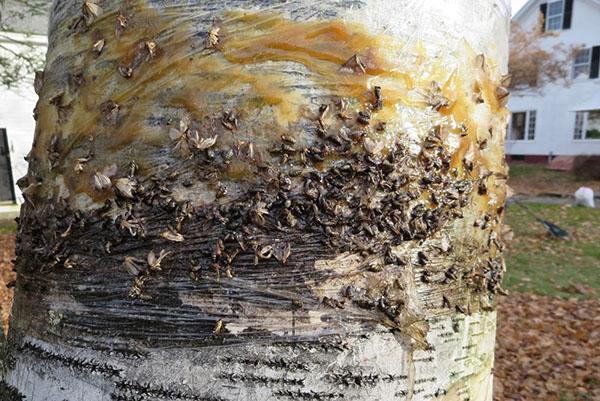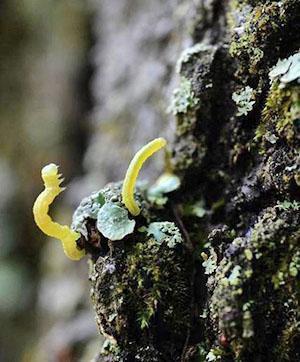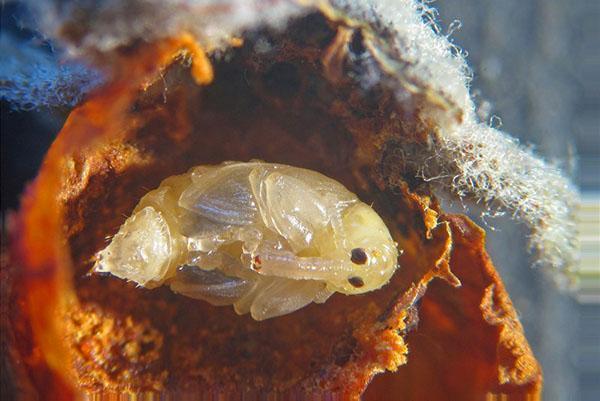Do-it-yourself fishing belts for fruit trees are a snap.
 Starting from the first warm days, a lot of insects become active at the summer cottage, which carry a serious threat to the health of plantings and the future harvest. Self-made trapping belts on fruit trees will help protect the garden from pests.
Starting from the first warm days, a lot of insects become active at the summer cottage, which carry a serious threat to the health of plantings and the future harvest. Self-made trapping belts on fruit trees will help protect the garden from pests.
What does such a structure look like and what is its purpose?
There are many design options for trapping belts, but most often it looks like a strip tightly attached to the trunk of a tree. A variety of materials can be used as a material for such protection, for example, a tight-fitting film, foam rubber, glass wool, non-woven material.
Purpose of using trapping belts on fruit trees

- collect live insects that move from the soil to the crown, so that later the summer resident can destroy them;
- Protect caterpillars, ants, beetles or larvae with an adhesive or insecticide applied to the belt.
Due to the fact that the belt can be on the tree from early spring to late autumn, it is effective against not only those insects that move to the crown from the ground surface or go down for further dispersal. It will help to significantly reduce the population of all kinds of larvae, for the time being hiding under the bark of cherries, pears, apple trees or other trees.
This fully applies to the fight against the flower beetle on pear and apple fruit trees. The larvae laid by small beetles destroy the buds from the inside, as a result of which the number of ovaries is reduced by times.
 Another enemy garden is a bark beetle. Its larvae make bizarre moves under the bark, weakening the tree and even leading it to death. How to deal with bark beetle on fruit trees? In addition to the use of insecticides that are not always safe during the breeding and departure of the pest, trapping belts on an adhesive base can be used to stop crawling insects.
Another enemy garden is a bark beetle. Its larvae make bizarre moves under the bark, weakening the tree and even leading it to death. How to deal with bark beetle on fruit trees? In addition to the use of insecticides that are not always safe during the breeding and departure of the pest, trapping belts on an adhesive base can be used to stop crawling insects.
The fruit trees, protected by their own hands, owe only to the trapping belts that the number of many crawling insects has significantly decreased during the spring-summer season. But is it possible to fight aphids on fruit trees based on the properties of trapping structures?
Yes, although aphids can fly from plant to plant, for the most part ants do. Therefore, their accumulations on young succulent shoots, leaf petioles and buds are so massive. If you cope with ants, then the number of aphids will be seriously reduced.
How to make a trapping belt for a fruit tree?
Structures that you can make yourself from scrap materials are divided into three classes.
Dry trapping belts are essentially traps designed to stop insects on their way to the summit and food source. The mechanism for protecting fruit trees from pests here consists in creating an obstacle, having reached which the pest could not continue its journey.
These can be smooth strips of plastic tightly attached to the trunk and skeletal branches, or all kinds of designs in the form of funnels, cones or skirts. How to make the trapping belt of the last, most effective variety for a garden tree?
 Operating procedure:
Operating procedure:
- For young plants, the top of a plastic bottle of various capacities is suitable.
- Previously, cracks and damage to the bark are cleaned and treated with clay.
- Cutting the container lengthwise and removing the bottom, an impromptu belt is put on the trunk with a bell to the soil.
- They are firmly fixed 70–80 cm from the ground with tape or foil so that insects do not have the opportunity to continue their way up.
- As insects are collected under the cone, they must be removed and destroyed. On average, the frequency of the procedure is 10-14 days.
In a similar way, you can make a trapping belt for a fruit tree with your own hands, simultaneously directed up and down.
 Porous and fibrous materials also help inhibit the movement of insects. For a trapping belt, you can use a rough burlap, foam rubber or mineral wool, which is wrapped around the trunk and tightly fixed at a level of 70-100 cm from the ground.
Porous and fibrous materials also help inhibit the movement of insects. For a trapping belt, you can use a rough burlap, foam rubber or mineral wool, which is wrapped around the trunk and tightly fixed at a level of 70-100 cm from the ground.
Another useful variety is trapping belts and the form of a strip fixed to a tree, processed insecticidal broad-spectrum... In this case, insects do not linger on the tape, but die, falling under the crown. Although it is not necessary to clean such a device, it is still necessary to renew the impregnation.
But the most popular are sticky trapping belts with an applied adhesive layer. As a basis for such plant protection, you can take a film, nonwoven fabric, cardboard or wax paper.
- The strip is fixed on the pre-processed trunk.
- After that, a thick layer of special adhesive is applied to it. If you cannot find glue for insects, a composition for rodents is suitable.
- The coating is replaced at least once a month.
 This type of trap belt can be useful from early spring to early winter, effectively neutralizing a wide variety of pests. If the base is made of a waterproof, resistant material, then it can be used many times, only by regularly changing the adhesive composition.
This type of trap belt can be useful from early spring to early winter, effectively neutralizing a wide variety of pests. If the base is made of a waterproof, resistant material, then it can be used many times, only by regularly changing the adhesive composition.